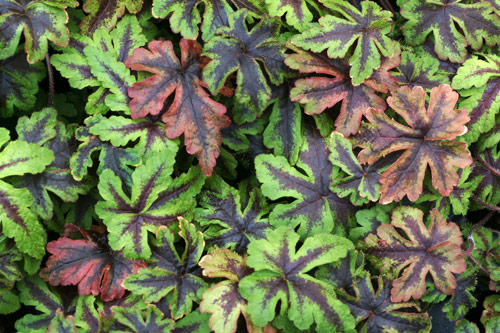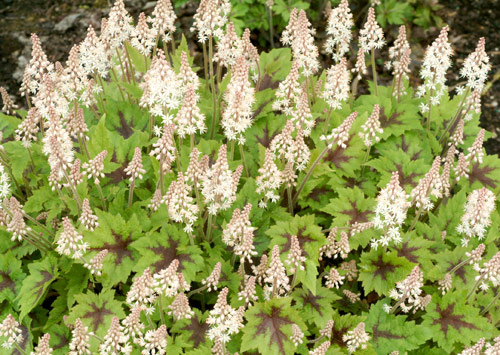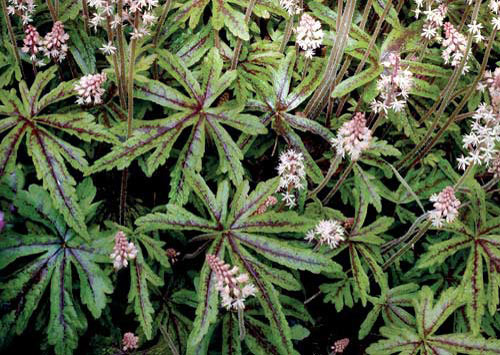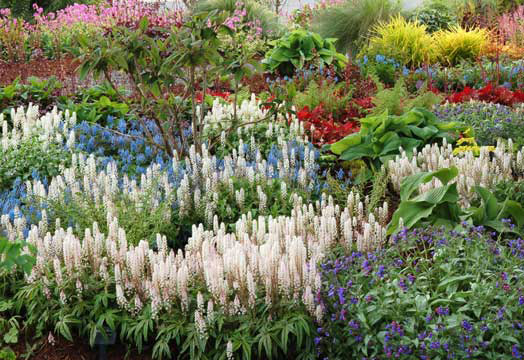 Terra Nova®'s Garden in May |
Ever since my romance with plants began 30 years ago, I have been driven to collect and breed hardy plants with gorgeous leaves. Among my favorites are the foamflowers (Tiarella spp.), natives of woodlands across North America and in Asia. But exceptional foliage isn't their only strong point. It's the contrast of frothy flowers against bold, maple-like leaves that makes them so worthy of attention. The native movement is in full swing, and planting these undemanding plants fulfill everyone's sustainability goals!
In recent years, hybridizers have lifted their paintbrushes to concentrate on this little group of lovely plants. Their newest selections and hybrids bloom longer, produce more and showier flowers, and often rebloom. Tough, evergreen below USDA Zone 5, and tolerant of the deepest shade, these superior foamflowers are finding a home next to hostas in many a garden. The hybrids all bloom better and are much more uniform than seed-grown varieties.
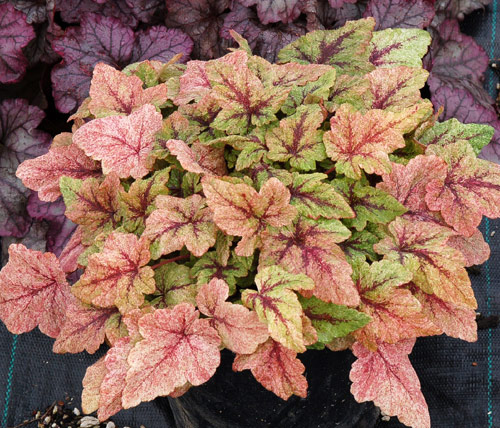 |
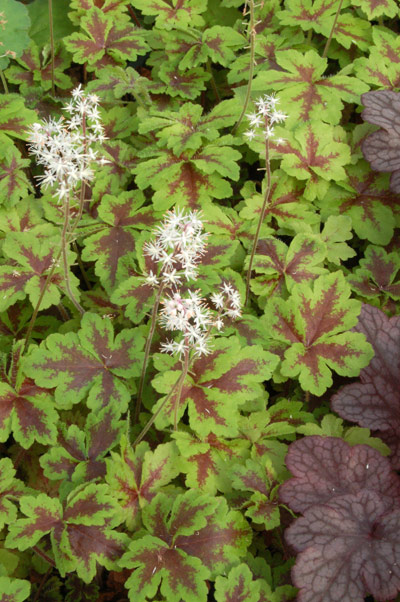 |
| Tiarella 'Mystic Mist' & Tiarella 'Crow Feather' | |
GROW FOAMFLOWERS FOR BOTH FLOWERS AND FOLIAGE
Foamflowers are aptly named. Wandering through the woods where these plants occur naturally, one can spy mounds of whitish, feathery flowers the color of seafoam in spring. Foamflower blossoms are sometimes accented with a pale pink or peachy cast, others have what could be described as a “warm” buff coloration.Breeders are working on developing brighter flower colors.
T. 'Spring Symphony' sports the brightest pink flowers reported to date. Some foamflowers are mildly fragrant. I sometimes liken their smell to that of cheap cologne, but I like that smell! The most fragrant variety I have sniffed is T. 'Eco Red Velvet' from Don Jacobs. Of my "children," 'T. 'Iron Butterfly' is tops in the "aroma arena." Flowering starts very early, sometimes preceding spring bulbs, and the flowers appear to be frost tolerant. The naturally occurring foamflower species are strictly spring bloomers, but some superior selections, such as T. 'Snow and Sapphires’, bloom throughout the summer. 'Jeepers Creepers' and especially 'Iron Butterfly' may even flower until heavy frosts begin.
On the foliage front, the new hybrids show astounding leaf shapes with vivid markings. Their leaves can have dramatically elongated lobes with freckles, splashes or bold black blotches as adornment. Their leaf edges can be baroquely ornate or smooth as silk, and the lobes may overlap like a pinwheel ('Crow Feather') or lie open like the wings of a butterfly ('Iron Butterfly').
These woodlanders have a second season of color in fall and winter
Tiarellas are terrifically under rated for their foliage impact in fall and winter. Nicholas Staddon, the new plants director at Monrovia Nurseries was blown away by the gorgeous hues leaves expressed one November at the nursery. Their leaves can turn orangey-bronze, as in T. 'Crow Feather', to purple-black, as seen in T. 'Ninja'. The variegated forms like T. 'Mystic Mist' add yet another color to the palette.
Late-season leaf color is an element to remember when planning fall border or container combinations, especially since the bronzes and burgundies of foamflowers combine so well with orange and red mums and plants in other "Halloween" colors.
CHOOSE FOAMFLOWERS WITH THE FORM YOU NEED
Foamflowers can be "clumpers," "runners" or "semi-runners." Clumpers remain well-behaved, forming mounds that slowly increase in size and become more floriferous as time progresses. In contrast, runners are wildly stoloniferous, overtaking large areas with their lovely netted leaves. Semi-runners, which I also call "creepers," are intermediate in habit, spreading perhaps 18 inches from the center of the plant in a year's time.
Clumping types look good planted en masse in the shade border or as specimens in containers or in the garden. Running types can be used as "weavers" intermixed with hostas or other bold shade plants. Semi-runners make an excellent groundcover, as they are dense enough to smother weeds. They also make fine container plants, spilling over the edges of pots and blooming on both the new and old growth.
Foamflowers are typically 12-16 inches tall in flower, but size varies. 'Spring Symphony' is just 8-10 inches tall in flower, but even the small varieties do spread, slowly filling the gaps between other plants. In general, clumpers will grow taller and fuller than runners.
As a rule, the running forms have the smallest, least showy flowers. (We’ve got better coming!) Semi-runners are close to clumpers in showiness, but nothing beats the floral display of a 2- to 3-year-old clumper!
WOODLAND CONDITIONS MAKE FOAMFLOWERS HAPPY
As woodlanders, foamflowers require a humus-rich soil, adequate moisture and good drainage. In Oregon, Pennsylvania and West Virginia, I have seen native foamflowers right at the edge of streams, sometimes clambering over moist rocks, competing with moss for the bits of soil that lodge in crevices.
In the Pacific Northwest, most varieties will grow in the deepest shade to full morning sun. Plants grown in afternoon sun will bleach during the summer but recover in fall with a full flush of foliage, showing excellent vigor and bronzing. In other areas, gardeners need to keep foamflowers in shady spots.
Since foamflowers are very hardy (growing in USDA Zones 4-9) and very heat- and humidity-resistant (I have seen them happy in Florida!), I consider them one of the few perennials that can live in every climate except the desert southwest. Foamflower roots usually penetrate the soil shallowly, limiting their drought tolerance. You'll get improved results by amending soil with generous amounts of humus before planting.
On a recent trip to Dallas Arboretum, I was shown Tiarella trials by the director Jimmy Turner. He was impressed how well both Tiarellas and Heucherellas (the hybrid between Heuchera and Tiarellas) do in the Texas heat. Deep shade is a must.
Sinclair Adam, Jr. (a foamflower guru affectionately known as the Pharoah of Foamflowers) suggests that where soils lack calcium and magnesium, dolomitic limestone and small amounts of Epsom salts be applied to make up the deficit. Although limestone will raise soil pH, foamflowers thrive in a fairly wide pH range from 5.5 to 7.5. Test your soil first to determine if a deficiency of any nutrient exists, and consult with your local cooperative extension for recommended products and application rates for your soil type.
CARE AND FEEDING OF FOAMFLOWERS
Foamflowers are quite easy to maintain. Trim off flowers after blooming, and feed and mulch once a year. I have foamflower patches 15 feet wide that I feed with a balanced (14-14-14), timed-release fertilizer from a whirlybird spreader in late winter (early February for me) before growth comes on. With the first warmth of spring, the fertilizer is there for the plants. I recommend using a micro-prill formula such as APEX 14-14-14 that releases nutrients in a very controlled way. For mulch, use leaf mold because it quickly contributes to the soil the humus foamflowers crave.
Some people prune winter-burned leaves off foamflowers, but I prefer to leave them on, as they protect buds from drying winter winds which can top-kill plants. CARE MUST BE TAKEN. Do not bury the crowns of the plants, especially with manure, this will KILL THE PLANTS! Foamflowers are often covered by fallen leaves in autumn and sprout through this layer in spring, but I like to expose their crowns to enjoy the earliest growth in February when I am desperate for green in the garden!
Foamflowers are relatively disease- and pest-free, but some forms are prone to powdery mildew, especially after being drought-stressed. An organic approach to controlling mildew is to spray the foliage with a baking soda/soap solution (see recipe at DIRECTION) or Sulfur. Other mildewicides should be wettable-powder-based (such as Triadimefon, Triforine, Thiophanate-methyl, Propiconazole, or Potassium bicarbonate) since petroleum-based formulae can burn foliage.
Vine weevil and strawberry root weevil are also occasional nemeses. Low-toxicity pyrethrins are effective against the adults with two considerations: timing (spray at dusk since weevils are nocturnal feeders), and timing (make 2-3 applications in late May to mid June). Weevilicide can also be attained by killing the larvae with parasitic nematodes (Nemasys). Don't apply nematodes too early in the year; larvae don't hatch until late summer. I usually drench in September when the soil is moist and warm. Remember to water before and after application. Weevil baits can also be helpful, or hand pick the pests at night and drop them in a bucket of soapy water.
Foamflowers look their best at 2-3 years of age. Divide large specimens very early in spring before the plants have leafed out. Simply push strong pieces of rhizome into fluffy soil to create a new plant. Hybrids will not come true from seed, yielding seedlings that display a hodge-podge of leaf shapes, many inferior to those of the parent plant. Curious gardeners and aspiring plant breeders who want to take their chances anyway should sow fresh seed on top of moist, sterile seed-starting mix. Cover flats with clear plastic and maintain a temperature of 70°F. Ensure that the seed remains moist, and you will see tiny seed leaves in three weeks. When seedlings have a pair of true leaves, prick them out into small pots such as the vegetable packs left over from last year's annuals and grow them on a few months before transplanting them into the garden.
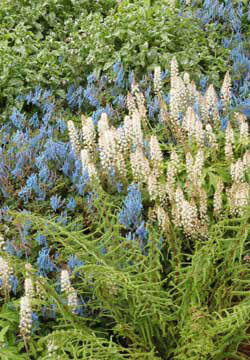 Tiarella with Corydalis and Athyrium |
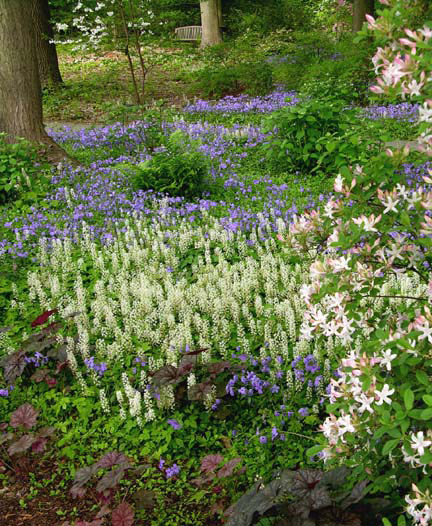 Pierce's Woods (Photo by W. Gary Smith) |
COMBINE FOAMFLOWERS WITH OTHER WOODLANDERS
Foamflowers provide a lovely foil to spring bulbs, lungworts (Pulmonaria spp.) and Hellebores (Helleborus spp.), and Dicentra which enjoy similar growing conditions. They make great companions for ferns like Athyrium and the more shade-tolerant types of coralbell, such as Heuchera 'Paris' and 'Green Spice'. Another good cohort is native wild ginger (Asarum canadense), often seen running with foamflowers on moist, rocky slopes in the wild. In containers, try mixing foamflowers with dwarf forms of impatiens. They are a natural with Hosta, contrasting their delicate texture with the overly bold Hosta foliage. Foamflowers are usually in full leaf and flower before hostas are entirely unfurled and thus "set the stage" for the show to follow.
W. Gary Smith, a landscape architect from Canada designed an amazing planting at Longwood Gardens in Kennett Square, Pennsylvania. In an area called "Pierce's Wood", he planted tens of thousands of Tiarella and contrasted it with Heuchera and Phlox divaricata for a breath-taking experience. His pictures are featured in this article.
Tiarella continue to contribute to the garden with extended bloom in some varieties, rich and interesting leaves all summer, and beautiful bronzing in fall and winter. With all they have to offer, I think you'll agree that every garden with a little shade should have a foamflower!
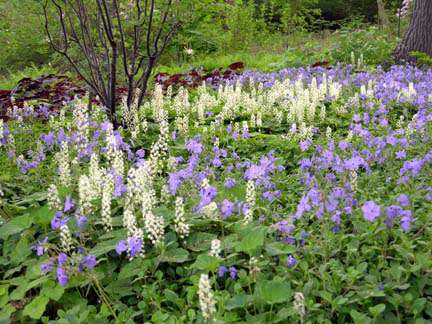 Pierce's Woods (Photo by W. Gary Smith) |
(Highlighted Varieties have active links)
| Tiarella 'Black Snowflake' |
Clumper |
2001 |
| Tiarella 'Black Velvet' | Clumper |
1998 |
| Tiarella 'Candy Striper' | Clumper |
2004 |
| Tiarella 'Crow Feather' | Clumper |
1998 |
| Tiarella 'Cygnet' | Clumper |
1998 |
| Tiarella 'Dark Eyes' | Clumper |
1996 |
| Tiarella 'Dark Star' | Semi-Runner |
1996 |
| Tiarella 'Filigree Lace' | Clumper |
1995 |
| Tiarella 'Freckles' | Clumper |
1996 |
| Tiarella 'Heronswood Mist' (Hinkley) | Clumper |
1998 |
| Tiarella 'Inkblot' | Clumper |
1997 |
| Tiarella 'Iron Butterfly' | Clumper |
1999 |
| Tiarella 'Jeepers Creepers' | Semi-Runner |
2000 |
| Tiarella 'Lacquer Leaf' | Clumper |
1998 |
| Tiarella 'Mint Chocolate' | Clumper |
1998 |
| Tiarella 'Mystic Mist' | Clumper |
2008 |
| Tiarella 'Neon Lights' | Semi-Runner |
2000 |
| Tiarella 'Ninja' | Clumper |
1998 |
| Tiarella 'Pink Bouquet' | Clumper |
1998 |
| Tiarella 'Pink Skyrocket' | Clumper |
2001 |
| Tiarella 'Pinwheel' | Clumper |
1996 |
| Tiarella 'Pirate's Patch' | Semi-Runner |
2004 |
| Tiarella 'Sea Foam' | Clumper |
2001 |
| Tiarella 'Snowflake' | Clumper |
1996 |
| Tiarella 'Spanish Cross' | Clumper |
1997 |
| Tiarella 'Spring Symphony' | Clumper |
1997 |
| Tiarella 'Starfish' | Clumper |
2000 |
| Tiarella 'Sugar and Spice' | Semi-Runner |
2004 |
| Tiarella 'Stargazer Mercury'™ | Clumper |
2004 |
| Tiarella 'Stargazer Venus' TN | Clumper |
2004 |
| Tiarella 'Tiger Stripe' (Oliver/Primrose Path) | Clumper |
1996 |
Resources:
Terra Nova® Website:
www.terranovanurseries.com
Charles and Martha Oliver's Book: Heuchera, Tiarella and Heucherella:
A Gardener's Guide
http://www.amazon.com/Heuchera-Tiarella-Heucherella-Gardeners-Guide/dp/0713490098
